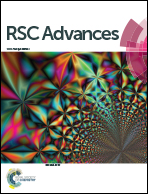Synthesis and characterization of a novel type of mixed matrix membrane: surface sieving membrane†
Abstract
A novel surface sieving membrane was prepared by attaching zeolite crystals on the polymer membrane surface. The top zeolite layer serves as a pre-screen layer which only allows the permeation of small molecules based on a molecular sieving mechanism. The separation factor of the new membrane was substantially increased by 300% for the pervaporation separation of a methanol–dimethyl carbonate mixture.


 Please wait while we load your content...
Please wait while we load your content...